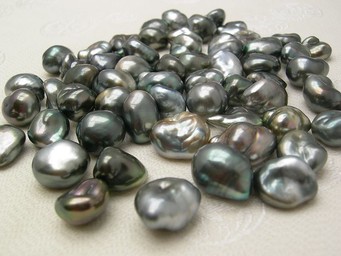Tahitian Keshi Pearls
Small Tahitian Cultured Pearls created by the oyster's premature rejection of the grafted nucleus, have been given the Japanese name of keshi. The name was adopted by Japanese pearl farmers to describe tiny non-nucleated pearls, grown by accident, that were often found inside oysters at harvest time.

"Keshi" means "poppy seed" because of their generally small size (usually 2-8mm diameter) compared to nucleated pearls. However, on rare occasions keshi of up to 18mm in diameter and 5 gram in weight can be found. Since there is no nuclei inside keshi tend to be highly irregular shapes and "flatter" compared to round, semi-baroque and baroque pearls.
Tahitian keshi come in the same colours as all Tahitian Cultured Pearls. Indeed the luster and colours of keshi are sometimes more intense than nucleated pearls. Keshi are sometimes regarded as closer in composition to a "natural pearl" since they are made up entirely of pearly layers. However, keshi still can't be classified as natural because they are a by-product of pearl culturing.
Tahitian keshi come in the same colours as all Tahitian Cultured Pearls. Indeed the luster and colours of keshi are sometimes more intense than nucleated pearls. Keshi are sometimes regarded as closer in composition to a "natural pearl" since they are made up entirely of pearly layers. However, keshi still can't be classified as natural because they are a by-product of pearl culturing.

Keshi are found in all mollusks, including South Seas pearls from Australia, Indonesia and the Philippines. They tend to come from smaller pearl farms as larger pearl operations have found ways to determine shortly after nucleation if the oyster is going to produce a keshi or a cultured pearl. If it is a keshi they will generally start the nucleation process again.
Consequently, due to this practice, keshi are becoming more difficult to obtain and their price has risen sharply in recent years. Tiare Black Pearl has hundreds of Tahitian and South Seas keshi of all sizes. Price is determined by weight. Smaller keshi are sold at AUD$150 per gram and larger keshi (over one gram) are sold at AUD $250 per gram. You can now take another 33% of all loose keshi prices. Come and visit us at our 'Pearl Studio' in Mornington, choose your keshi from a wide selection of samples and wait while we transform it into a ring, bracelet or necklace!